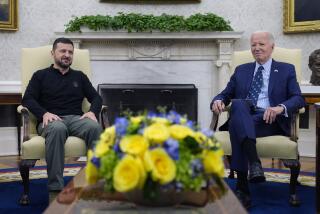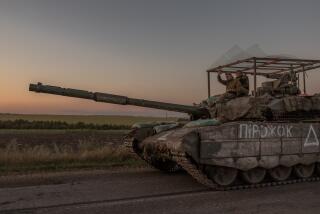Next Step : Ukraine Starting Peace-Into-Profits Recycling : Experts from three nations are dismantling and selling the country’s huge arsenal of bullets, bombs, missiles and other Cold War materiel.
- Share via
ICHNYA, Ukraine — In a desolate forest in northern Ukraine, American know-how is transforming a vast junkyard of the Soviet military’s dangerous detritus into a landmark peace-into-profits recycling facility.
Hundreds of thousands of tons of bullets, bombs, mines, missiles and other Cold War relics left in Ukraine in the wake of the 1991 demise of the Soviet Union will be dismantled and their component metals and chemicals sold. The process will be handled by Alliant Kiev, a joint venture between the Ukrainian Defense Ministry; Alliant Techsystems, a Minnesota-based defense contractor; and Rapierbase, a British metals trading company.
“Let everything here work for peace instead of what it was meant for,” said Ukrainian President Leonid D. Kuchma at this month’s opening of Alliant Kiev’s reclamation facility at Artillery Munitions Base A1479, 130 miles east of Kiev.
“Ukraine’s need for this is obvious by just looking around here,” added Defense Minister Valery Shmarov, referring to the base’s sprawling complex of open-air shelters stacked with thousands of crates full of weapons and ammunition.
“There’s some overloading, as you can see,” he pointed out.
Most notorious for the 176 nuclear missiles left stationed here when the Soviet Bloc collapsed, this France-sized country also inherited huge storage depots of conventional munitions.
Base A1479, reportedly one of six stockpiles in Ukraine, was also used as a dump for munitions withdrawn from former Soviet Bloc countries in Eastern Europe by Moscow’s departing armies. According to Ukrainian Gen. Ivan Tsaryk, the base commander, A1479 has more than 300,000 tons of materiel, some of which is of World War II vintage.
Such superpower-sized stockpiles are far too big for independent Ukraine’s more modest military needs, Ukrainian officials said.
“Many of these are old, obsolete weapons, and we’ll only destroy the ones we don’t need,” responded Shmarov when asked by a Ukrainian journalist if Alliant Kiev’s plans would leave Ukraine disarmed and defenseless. He added that Ukraine is close to completing its own ammunition-manufacturing industry, something it did not have when the Soviet Union collapsed.
Alliant Kiev’s initial contract is to reclaim 220,000 tons of ammunition from throughout Ukraine over the next five years. But in light of estimates that there are 800,000 tons of surplus, company officials are hopeful that there will more work ahead.
“We could be here for 10 years,” said Ken Jensen, the president of Alliant Techsystems, until recently the largest supplier of munitions to the U.S. Defense Department.
With U.S. defense budget cutbacks and an estimated 35 million tons of munitions worldwide made superfluous by the end of the Cold War, there is more money--per unit--in taking weapons apart than in building them. Alliant Techsystems hopes that Alliant Kiev--and a similar but smaller operation in the former Soviet republic of Belarus--will spin off business in munitions recycling in other countries, including the United States, where Alliant Techsystems officials say there are an estimated 500,000 tons of surplus munitions.
Pinned to that hope is Alliant Kiev’s $15-million investment in four navy-blue modules--or mobile mini-factories--that house the company’s patented fluid-jet cutting equipment used for dismantling munitions.
“This is the first facility in the world to use this technology for demilitarization on such a scale,” Jensen said.
The project got a boost when the Overseas Private Investment Corp., the U.S. government agency that insures private American investments in other countries, pledged $10 million in financial assistance, making Alliant Kiev the first Ukrainian project to receive such aid.
On television monitors in Module 3, Kuchma, U.S. Ambassador William Miller and other dignitaries who attended the ribbon-cutting ceremony watched as the automated fluid-jet cut the explosive component from an antitank artillery shell.
Actually, the demonstration shell was a dummy. But once the facility is up to its planned capacity--dismantling four or five tons of explosive ammunition rounds a day and employing 1,000 local workers--an eight-foot blast-wall of sand, Styrofoam and steel will protect workers from the process. According to Alliant Kiev safety experts, the wall would direct any explosion west, into the birches and pines, rather then east, toward the workers and munition stockpiles.
Base A1479 was selected for Alliant Kiev’s operations because its isolated location would mean limited injuries and property damage in case of an explosion, explained Alliant Kiev representative Nate Glazer. Ichnya, the closest village, is 12 miles away.
Nevertheless, the purpose of Alliant Kiev’s state-of-the-art technology is to reduce that risk. Using enormous pressure to force an abrasive liquid through small openings, the fluid-jet is a precise, liquid “knife.” But unlike a regular knife, it doesn’t create sparks--a crucial consideration when working with explosives.
According to Alliant Kiev, its system is environmentally friendly because it uses much less liquid (usually water) than other fluid-jet technologies, and virtually all of the liquid is recycled.
After the fluid-jet isolates the explosive material, the extracted material is mixed with water and pressed into moist cakes that can be safely transported and processed into fuel, fertilizers or mining explosives.
The metals--brass, copper, aluminum and steel--salvaged from the shells are what have significant monetary value. Selling them as scrap on world markets over the next five years could garner Alliant Kiev $100 million, to be split among the Ukrainian government, which holds a 51% share in the operation, Alliant Techsystems and Rapierbase.
“Enabling Ukraine to convert obsolete munitions into commercially sold byproducts will provide financial resources that can be directed to economic problems (in the military) such as housing, job training and employment,” Shmarov said.
Because the name of Ichnya, the Ukrainian village, is so similar to that of Chechnya, the embattled Russian republic, the contrast between Ukraine’s plowshares-into-profits operation and Russia’s expensive and bloody war against separatists intruded on the otherwise cheerful atmosphere at Alliant Kiev’s opening.
“When word got out about this, people at first thought I was going to Chechnya,” said President Kuchma, prompting one man in the crowd to comment quietly: “Except in Chechnya, Russia is dumping its excess ammunition on its own citizens.”
(BEGIN TEXT OF INFOBOX / INFOGRAPHIC)
Meeting the Deadline
Ukraine has until November to reduce its weapons and troops to levels set by the Conventional Armed Forces in Europe treaty. Here’s how it’s doing:
CURRENT LIMIT Manpower 495,150 450,000 Tanks 5,394 4,080 Armored Combat Vehicles 5,803 5,050 Artillery 3,725 4,040 Attack Helicopters 270 330 Combat Aircraft 1,460 1,090
NOTE: Current as of Dec. 15, 1993, the latest complete data available.
SOURCE: “The Military Balance: 1994-95”
More to Read
Sign up for Essential California
The most important California stories and recommendations in your inbox every morning.
You may occasionally receive promotional content from the Los Angeles Times.










